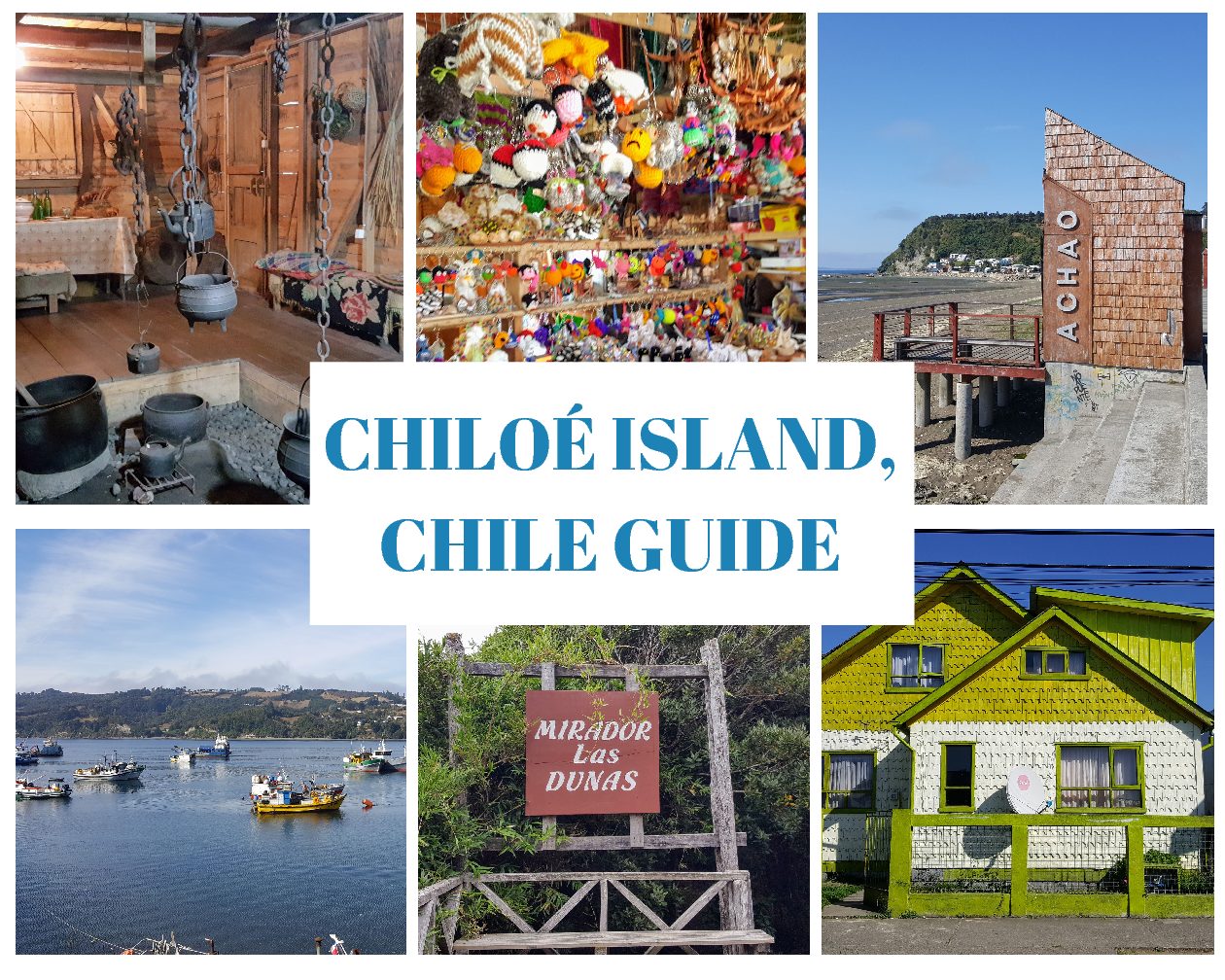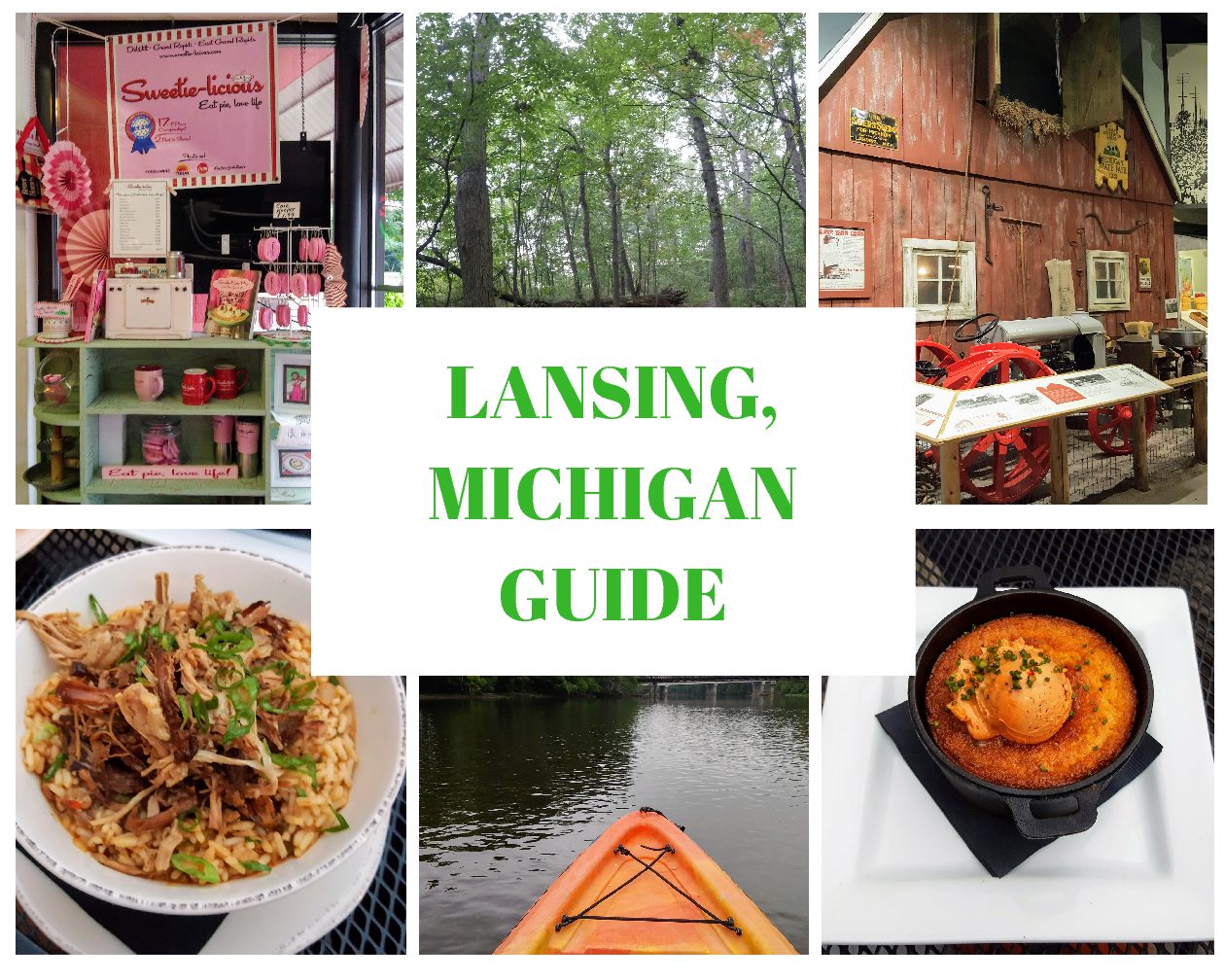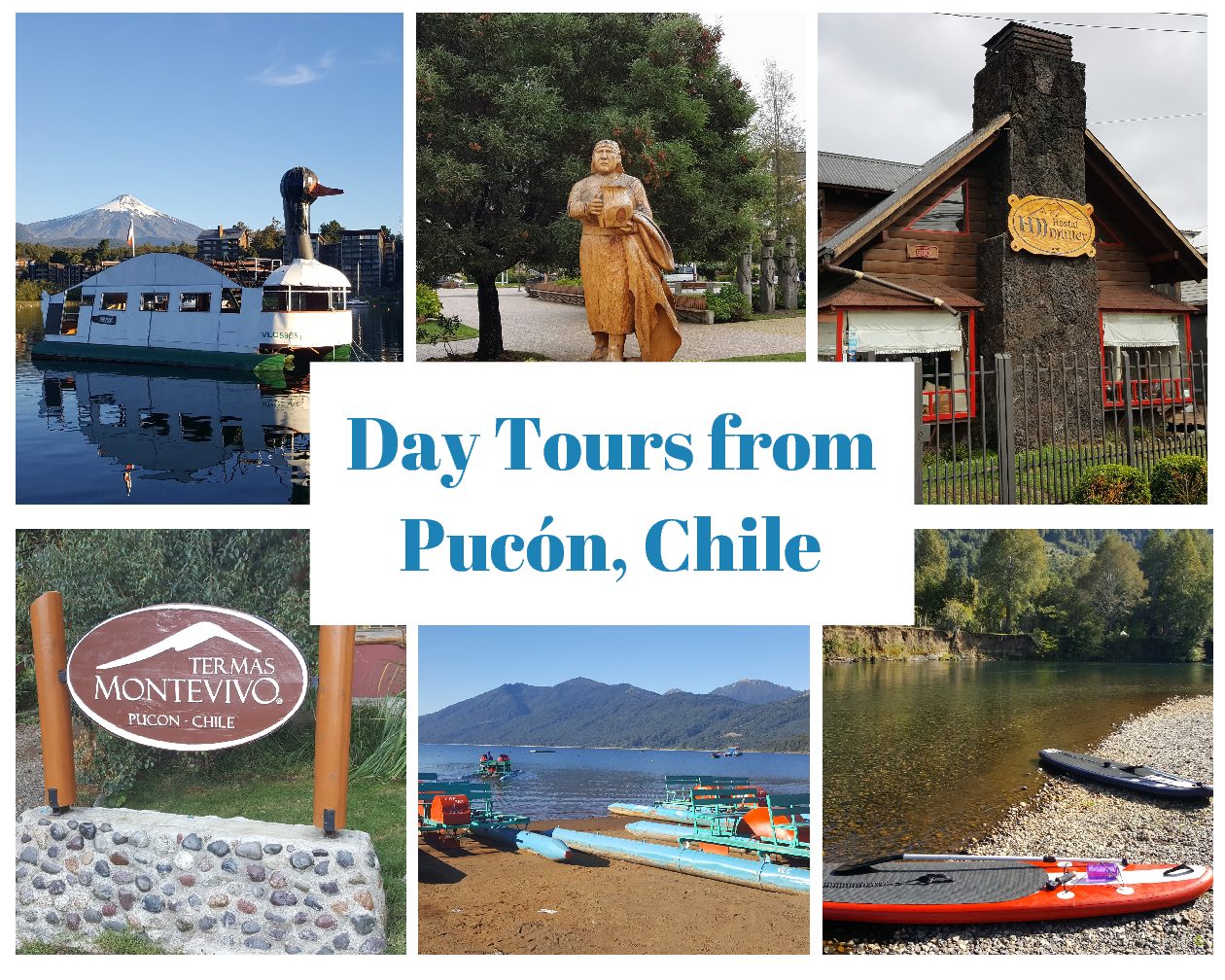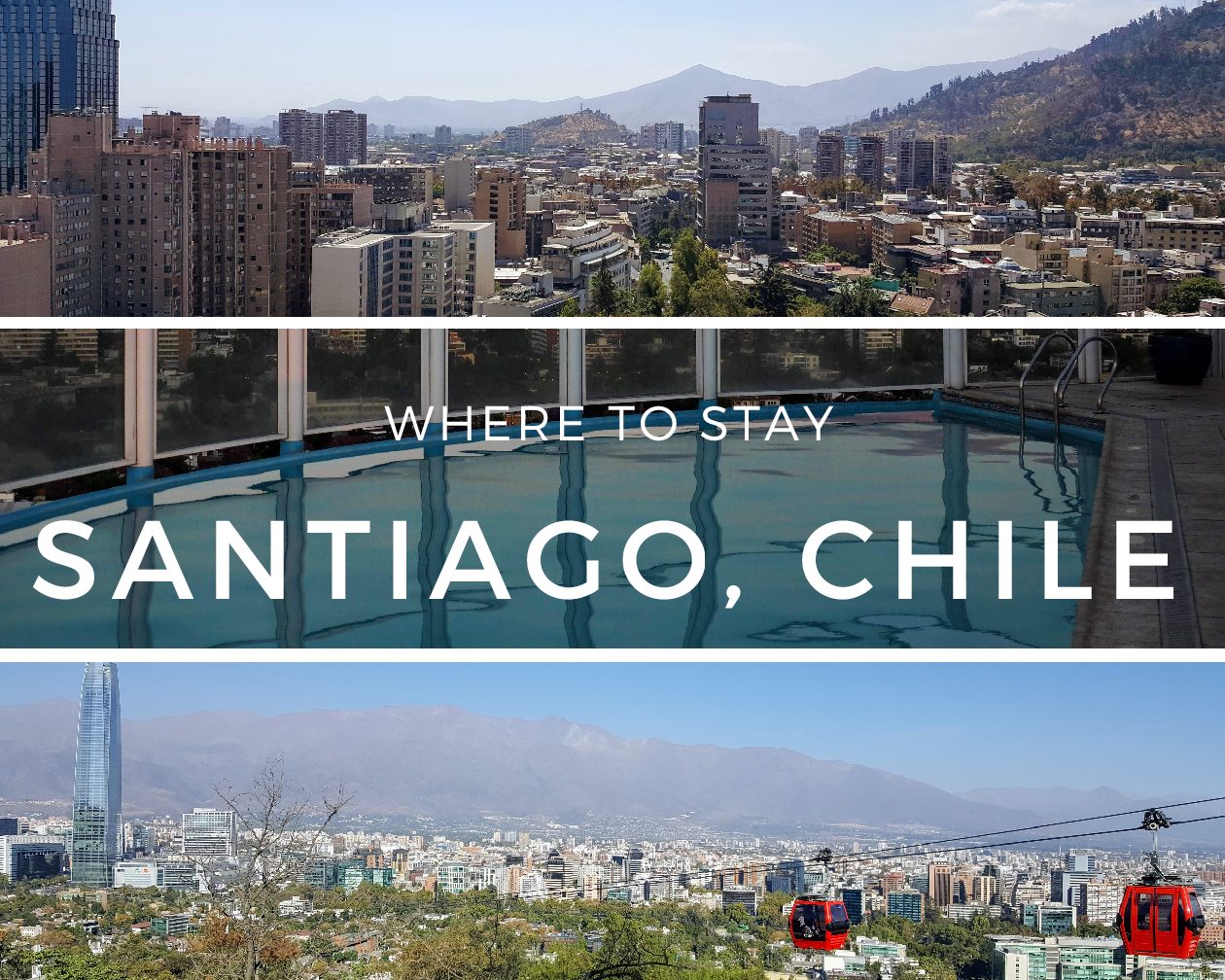
Chiloé Island, Chile Guide
This post might contain affiliate links. That means I may earn a small commission at no extra cost to you, if you buy through my site. I appreciate your support of my site.
Other than southern Patagonia and the Atacama Desert, I didn’t know where else there was to go in Chile. Then I came across a place not yet discovered by the masses of tourists. A Chilean Island full of creaky wood buildings, world heritage churches, uninhabited places, local mythology, and unique seafood dishes. If this sounds enticing, read on to see how you too can visit the magical island of Chiloé. Chiloé Island (or Isla Grande) is the perfect place to eat some amazing seafood and see what local life in central Chile is like.
How to Get to Chiloé Island
Flying to Castro
The easiest way to reach Chiloé Island is to fly direct from Santiago into Castro, which is the capital of the island. Be aware that there are limited flights flying to the island, usually only a few times a week directly from Santiago.

I thought it was so cool to fly into Castro. It is the smallest airport I have ever been to! We got off the plane on the tarmac and could see people waving to family and friends only a short distance away on the other side of a fence. A group of people were lined up outside of the building waiting to board our plane back to Santiago. I know they were waiting for our plane, because it was the only plane at the airport!

From outside you walk directly into baggage claim, most likely the size of your living room! Within minutes you have your luggage and can be out the doors and into your car. The most efficient airport ever!
Getting from Castro Mocopulli Airport to Castro
You can rent a car from the airport or take a shuttle to Castro. Within baggage claim, right before you exit, there is a little stand where you can pay for a shuttle. It only costs about 4.000 CLP ($5.86 USD).
The shuttle is immediately outside of the airport doors, you can’t miss it! Everything runs so smoothly at the airport, that the shuttle leaves shortly after the plane arrives. It takes about 20 minutes to get to the center of Castro. The people that run the shuttle are friendly and took me directly to my hospedaje (guesthouse) and made sure I knew where it was.
Bus to Castro
You can also take a bus to Castro from various cities around Chile. Common options are from Puerto Montt (you can fly into Puerto Montt) or Punta Arenas if you are coming from Patagonia in the south. Use recorrido to check bus schedules. Be aware that all bus options are not on recorrido. You can always go to the bus station where you are coming from and check the options. Many bus companies do not have online schedules or ticket options.

After my stay in Castro I took a bus about 4 hours to Puerto Varas. I went with ETM bus company and found the bus to be very comfortable. There are only three seats across and the seats have footrests and recline much more than buses I am used to traveling on.

The bus drives directly on the ferry and you can get out and walk around during the crossing!
Ferry to Castro
Your final option, unless you want to swim, is to take a ferry. Not the short ferry between Pargua and Chiloé Island that I took with my bus. You can take a ferry to Quellón on Chiloé Island from various ports in Patagonia. Check all the routes with Naviera Austral.
Getting Around Chiloé Island
If you aren’t planning to rent a car, you can still get around the island easily taking tours and using public transportation on your own. It is best to base yourself in Castro.
Within Castro you most likely won’t need any transport, other than your own two feet. Be prepared, there are some steep hills though!

To visit other towns on your own, go to the bus station in Castro to check times. Most of the local companies don’t print schedules or have websites. You will need to look at the different companies windows to see where they go and at what times.

Some don’t even have ticket windows and you have to look at the buses to see where they are going. There is a sign in the front window with the end destination. Buses to Dalachue, Achao and Chonchi are about every 15 minutes from around 7am to 8:30pm. Ask someone in the station or any local and they will have more information. Speaking Spanish is definitely very helpful with this!

The easiest, but also more expensive option, is to take guided tours. Read below for where you can go on tours and the best tour companies.
When to Visit Chiloé Island
The busiest month of the year is February. I was told that this is when the majority of Chileans travel. If you are traveling solo and hope to see the penguins I would recommend visiting between December and the middle of March. By the end of March the penguins were gone already and there wasn’t a whole lot of tourists around. This might sound like a good thing, the lack of tourists part, but if you are traveling solo it will be harder to book tours and you will have to pay higher rates.
Where to Stay in Chiloé Island
While visiting Chiloé Island it is best to stay in Castro, especially if you aren’t renting a car. The airport is in Castro, as well as the larger buses to the main cities around Chile and local buses to the smaller cities on the island. Most guided tours also begin from Castro.
There are a lot of very steep hills in Castro, so choose your accommodation carefully! What may look like only a 5 minute walk is a short walk, yes, but an uphill one.
Hospedaje Amapola is in the perfect location. It is only a few minutes away from the bus station (with no hill climbing needed!) and 15 minutes walk or less from anywhere you might like to go in Castro.

While I do recommend that you stay at Hospedaje Amapola, I have to say that the beginning of my stay was rather confusing. Even though I think I speak decent Spanish, Chilean Spanish is very hard for me to understand. When I arrived at the hospedaje I couldn’t understand a word the woman said and didn’t know if I had just walked into a random person’s house!
I was shown to my room. There was no bathroom in it as I had requested, there were a bunch of unknown doors everywhere. I asked if I needed to do anything, but she said to just rest. After pondering what to do for awhile, everything eventually got figured out with the main host. I had an entire area to myself complete with private bathroom, which I referred to as the “west wing”.

The hosts were friendly, especially the main host. I did have a few awkward moments though. Every morning during breakfast I received a piece of dessert. This is very common in Chile, but I prefer my sweets later in the day. I asked to eat it later and they happily wrapped it up for me. Later in the day I came out of my wing to eat it at the dining room table. Several family members were watching TV nearby. As I was eating my dessert, one by one they slowly left the room! I didn’t quite know what to make of that!

Overall the hospedaje is probably the cleanest place I have stayed in the last few weeks and has a very reasonable nightly rate, so I would recommend it for your stay in Castro!
Where to Eat in Castro
What to eat on Chiloé Island? Seafood is the way to go! How much fresher could you get, from an island with one of it’s main industries as fishing? Curanto is the traditional dish from the island, it is full of meat, seafood and potatoes. I learned on one of my tours that Chiloé Island doesn’t have all the certified organic food, but that’s what you will be eating. Basically Chiloé Island has been home to many farm to table restaurants, before farm to table became trendy!
Restaurant Don Tito

Restaurante Cazador

Ernesto Riquelme 1212, Castro, Isla Chiloe
Cazador is located in one of the Gamboa Palafitos. It has a cozy interior with views of the water. The menu is small with only a few appetizer and entree choices. They are mostly seafood dishes with local ingredients. I visited with someone I met on one of my tours and we both ordered the one thing on the menu that I could almost fully translate! I can’t remember exactly what it was, but it was some sort of traditional lamb dish that came in cast iron skillets. It also came with two teapots of some sort of sauce! It’s a trendier bistro type place, so the food was good, but the portions were small and pricey. It wouldn’t be the type of place I would go to regularly, but I would recommend it for the dining experience and some traditional cuisine from the island.
Restaurant Sacho

Thompson 213, Castro, Isla Chiloe
Another place for typical Chilote food that over-looks the water. There are more choices on the menu and the prices are reasonable as well. I went here my last night on the island and had my heart set on trying Curanto. Sadly, they didn’t have any Curanto on the menu and I had to go for a similiar dish with mussels, clams, sausage and a large potatoe. Similiar to the night before at Cazador, I am glad I gave a local dish a try, but I didn’t love what I ordered.
Cafe Magnolia

Eleuterio Ramírez 595, Castro, Isla Chiloe
I didn’t actually get to eat here, but it was recommended to me by my hospedaje host and it looked good. I took a quick peek inside the cafe. Especially if you are looking for something a little lighter or less Chilean.
What to Do & Where to Go in Chiloé Island
World Heritage Churches
Churches are a big deal on Chiloé Island. You should know right away that for any town you visit one of the top things to do will be to visit the church. There are 16 churches around the island that are designated as world heritage sites. Several tours will take you around the island to visit the churches. Personally I don’t think you need a tour to see the churches. All you need to do is hop on a local bus and wander around the town and you will find the town’s church.
Castro

The best thing to do in Castro is to simply walk around and admire all the wooden houses. I found some triangle shaped ones and a lot of uniquely colored ones. Make sure to check out the palafitos, the stilt houses over the water. They are located in four areas of the city. You can rent kayaks and take boat trips along the water. It’s best to walk down to the waterfront to see what is available.
Day Trips from Castro
To me what made Chiloé Island towns so special was the lack of tourists and the local feel each town possessed. Other than Castro, which has a slightly larger population and a busier feel, every town felt very sleepy. The towns are pretty similar with a church, a market, a plaza, a small free museum and a place to walk along the water. Don’t go expecting world class attractions, visit the towns to interact with the locals and get a sense of what life is like on the island. Also expect to have some great local meals.
Dalcahue

Dalcahue, only 30 minutes away from Castro, is an easy town to visit on your own. You can visit the artesian market, check out the church, walk along the water and visit a small museum.

It is a great town to try some fresh seafood. I was the only one at Cocineria Dalcahue, a little seaside place which as google says, does “down home cooking”. During my lunch I watched as one of the two chefs/waitresses made home-maid bread on the next table over. The lady agreed that I could take her picture and smiled for the camera. Then she said something in Spanish along the lines of, “no, I need to be in a working pose!”
Visiting Tips: There are paid toilets by the artesian market. Take the bus towards “Dalcahue” from Castro and get off in the center of Dalcahue (you can wait until you see water and then get off at the next stop, or just get off when most people get off).
Achao

When you are done exploring Dalcahue, get on a bus to go to Curaco de Velez or Achao on Quinchao island (same stop where you got off the bus coming from Castro). At lunch in Dalcahue I asked the waitress how to get to Quinchao and she kept telling me to take a bus. I kept saying no I want to take the ferry across. Finally, I understood that you can’t take the ferry unless you are on a bus or a bike. The bus drives directly on the ferry. In Achao there is a nice long beachfront to walk along.
Visiting Tips: Get off the bus in front of the artisan market (center of town). There are paid toilets at the market. You can take the bus directly back to Castro from Achao or from Curaco de Velez.
Chonchi

Guess what you can do in Chonchi? You can visit a church, walk along the water, check out the small museum and visit an artisan market. Who would have guessed?
Visiting Information: There are paid toilets at the artisan market and free ones at the museum. You can take a bus from Castro and combine your time here with a visit to the National Park or the Muelle de Alma Hike (see below for tours).
Ancud
Ancud is a city in northern Chiloé Island. It is most well-known for its penguin colony. I was warned that at the end of March I might not be able to see penguins, but of course I had to give it a try. Unfortunately, not a single penguin was around! I was hoping there would be a loner who lagged behind, but no such luck. Regardless, I always enjoy being out on a boat, even one named the Titanic III! We didn’t ask what happened to Titantic II! We got to see some birds, learn about the area and take in the pretty blue water!

After the boat tour we walked along the beach and had a delicious beachside fish lunch at Restaurant Bahía Puñihuil.
Queilén
The one place that I wanted to visit on the island, but didn’t get to was Queilén. A boat tour with the opportunity to see birds, penguins, sea lions and dolphins was what was luring me to visit. You can do this on your own or with a tour company. I emailed Quilun Ecoturismo Marino, the company that does the boat tour, and they weren’t sure if there would be enough people to run the tour or not.
Chiloé Island Guided Tours
Guided tours are a great way to see the island without having to figure out how to get around. They are the best option for learning about Chiloé and interacting with locals and other visitors. Also they are great for exploring outside of the towns and having active adventures in very uninhabited natural spots around the island. Here are the two I took and recommend.
Kayaking & Penguin Boat Tour

My day tour with ChiloEtnico began with a pick-up at my hospedaje in Castro. We then headed north for kayaking in Chepu River. Before we began our paddling we basically had to walk through a jungle! I can’t remember the name of the plant, but the leaves that we had to swat away and duck under were huge!

Chepu River has some of the calmest water I have ever paddled on. We didn’t see another person, boat or sign of life the entire time we were out on the water! Well, human life that is. We did spot a sea otter and a lot of birds. Chiloé Island is known for being a mystical place and with the hazy morning sunlight I definitely could see why!

After kayaking we headed to Ancud to try and see the Humboldt and Magellan’s Penguin colonies and eat lunch. Even though we didn’t get to see any penguins, I’m glad I choose this tour. Juan Pablo offers many other options of tours that you can choose from to discover the island. He is a great guide that speaks English very well and knows and loves the island he calls home.
Visiting Information: You visit a house before kayaking where you can change clothes and use the toilet. You can leave anything there, because you end the kayaking in the same spot. There are toilets at the restaurant and at the beach where the penguin boat tour takes place.
Chiloé National Park & Chonchi

The other full day tour I did on Chiloé Island was with Siempre Verde Tourism to Chiloé National Park and the town of Chonchi. After a quick stop at Huillinco lake, we spent the morning hiking on two different paths in Chiloé National Park. The first one went through a Tepual forest.

The next one went through some sand dunes to the beach! I was surprised to see some horses grazing along the beach. The hiking was perfect, with interesting scenery and foliage, but easy enough on my leg (recovering from an injury). José, my guide and owner of the company, knew an impressive amount about the plants and animals of the forest. Plus I finally got to learn about the local mythology. I had been waiting my whole trip to learn about the myths and legends that I had read about online.

After the park we had lunch nearby at a restaurant that I unfortunately do not remember the name of. I was yet again impressed with the local food. The family who owns it grows a lot of the food in their garden and buys fish from the local fishermen. I tried one of the native potato varieties from the island. It was purple and tasted different from any potato I have had before! The warm and cozy interior made the eating experience complete. After lunch we headed to Chonchi to tour the town.

You can visit the park and Chonchi on your own, but I was happy to go with Siempre Verde Tourism. It’s always risky to try food from a forest when you don’t know what it is. Thanks to José I got to sample some native fruits and berries during our hike. He was another great guide with good English skills and a lot of knowledge of the island. He offers many different tours of Chiloé.
Visiting Information: There are toilets at the national park information center that you can use before, between and after each hike.
More About Chile
- Santiago: What to Do in Santiago, Museo Histórico Nacional review, Museo de la Memoria y los Derechos Humanos review, Where to Stay in Santiago, Barrio República Neighborhood Guide
- Puerto Varas: Rafting & Kayaking
- Pucón: Day tours from Pucón
- Central Chile 3 Week Itinerary including Santiago and the Chilean Lakes District
Not quite what you are looking for? Don’t worry, I can help! Through my Personal Travel Planning service I can plan the perfect Chile itinerary to meet your travel needs…or any other place you dream of visiting!
Pin It!!
















6 Comments
federica
I have never heard of this island before and I was intrigued by the churches. Do you know what is peculiar to them?
admin
I don’t know exactly why they were designated as world heritage sites. I do know that the churches were all built in the 18th and 19th centuries and that they were built in the ecclesiastical wooden architecture style.
Matilda
I had not heard of Chiloé Island before but I like that it is not yet discovered by most tourists. I love walking around so I would have a great time exploring all the little towns and seeing the beautiful churches.
admin
If you enjoying walking around in new places, you would love Chiloé Island! Chiloé Island is very safe and easy to explore on foot.
Alissa
Thanks for sharing this post! Chiloé Island seems so quaint. I would love to visit the national park – beautiful landscapes. Chile is pretty high on my bucket list and it seems like there is sooo much to see and do there – now I have even more ideas! 😀
admin
There is so much to see and do in Chile! It is a beautiful country and I would definitely recommend a visit to Chiloé Island.